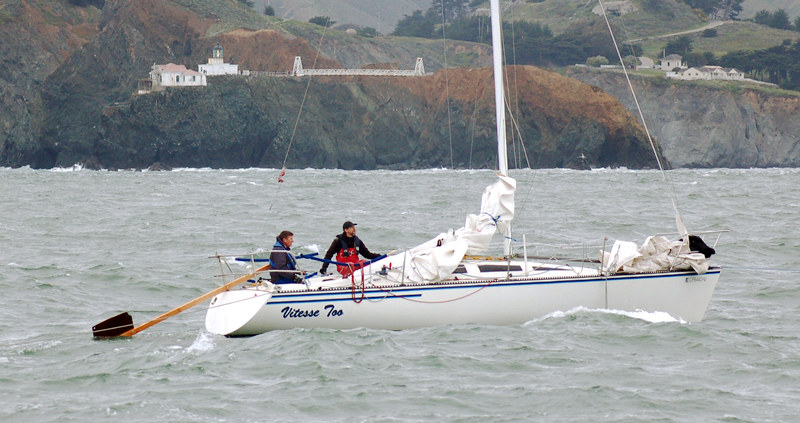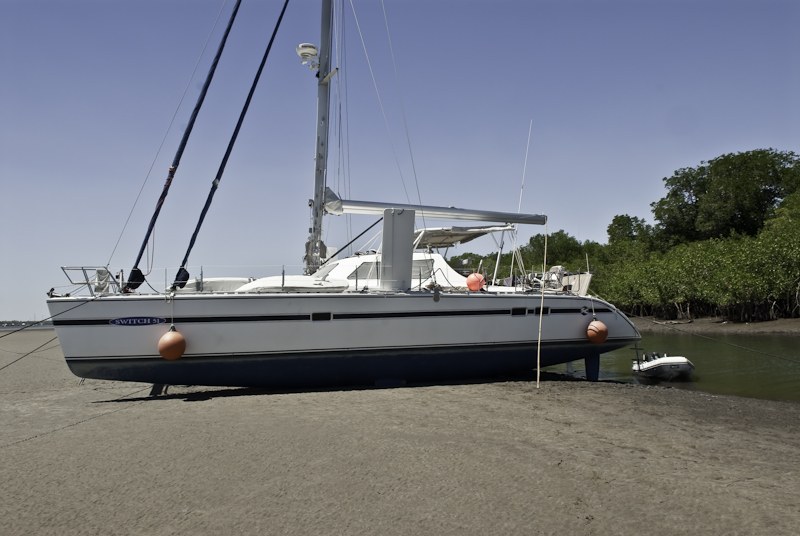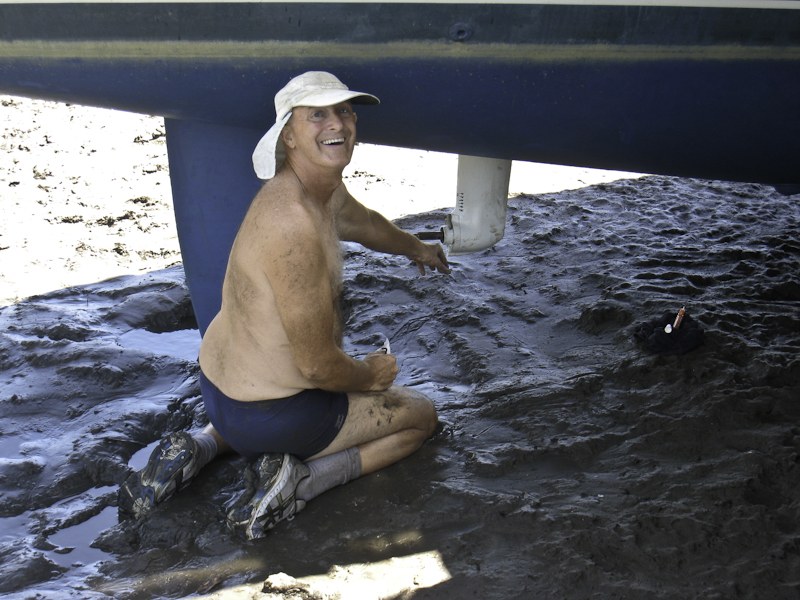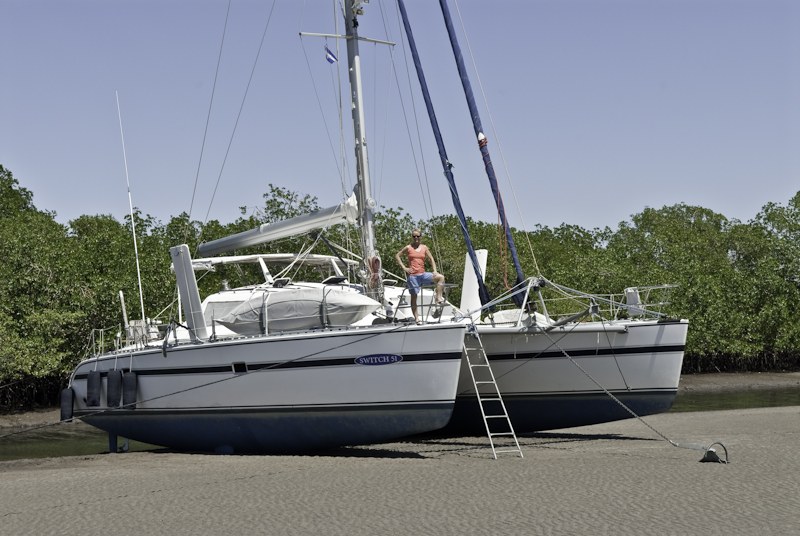
No Direction Home

© Latitude 38 Media, LLC
Grant Hayes and crew Bill Schwob were about halfway back to from the Lightship when they heard the dreaded ‘bang’. It was a riveted piece holding the rudder shaft together on Hayes’s Hobie 33 Vitesse Too. Without control, they suddenly went from doing pretty well in Saturday’s Doublehanded Lightship Race to spinning into a roundup with no way to steer out of it.
Although one of the toughest and best-made ultralights out there (watch this Hobie 33 Crash Test YouTube video sometime), H-33 rudders are ‘notoriously’ weak in this area. Fortunately, Grant and Bill were aware of the potential problem, and were prepared. Or thought they were. Once they wrestled the sails down, they deployed an emergency rudder they carried aboard. It had worked okay during tests in calm water, but proved useless in the bumpy conditions in the ocean. Their inboard engine also proved ineffective, as the prop is offset to one side and the rudder couldn’t compensate for it. But the scariest part of the whole adventure wasn’t the roundup, or getting the sails down. It was that the wind, waves and windage of the bare-poles boat conspired to start it sailing north at about four knots — right toward the Potato Patch.
They called the Island YC race committee, and then called for assistance. The first tow was provided by the nice folks on the Columbia 30 Tutu, who were not sailing the race, but had been out in the channel practicing. However, despite Grant and Bill deploying a drogue made from a bosun’s chair, the slippery Hobie kept surfing up to overtake Tutu. The Coast Guard took over the tow off Point Bonita and got Vitesse Too safely into Horseshoe Cove. “A big thank you to both Tutu and the Coast Guard,” says Grant. "They both did a terrific job.”
Happily, there was no ‘collateral’ damage to the boat, sails or crew. Even the rudder and lower shaft stayed attached and were unharmed. Hayes hopes to have the steering repaired in time for the SSS Corinthian Race on April 11.
Ship Damage by Its Own Container
In one of those odd twists of fate, last week a ship lost 31 containers in a storm off eastern Australia — and was itself damaged by one of them! The bit of poetic justice occurred aboard the Hong Kong-flagged Pacific Adventure near Moreton Island off the Queensland coast. It was unclear whether the ship hit the container, or the container was swept into the ship, but the result was a spill of up to 25,000 gallons of fuel oil, which drifted ashore and blighted 10 miles of coastline on Queensland’s popular Sunshine Coast and offshore islands. But Murphy’s Law wasn’t done yet: one of the containers — all of which were full of ammonium nitrate — burst open before going over the side, spewing three tons of the the poisonous white powder all over the midships portion of the ship. The crew managed to stop the fuel leak by pumped fuel from the damaged tank into other tanks, but as a final insult, the ship sprang a second oil leak as it pulled into Brisbane on Friday.
Going Back to the Old Ways

©2009 Latitude 38 Media, LLC
One of the biggest problems with larger cruising cats is that there aren’t very many places that have big enough Travel-Lifts or marine ways to haul them out. So as Scott and Cindy Stolnitz of the Marina del Rey-based Switch 51 Beach House discovered, sometimes it’s best to just go back to the old ways. We’re talking careening.
Beach House had to be careened because Scott thought they’d lost their port transmission while crossing the Gulf of Tehuantepec. Getting a replacement transmission from the States was a snap. Using DHL Express, it arrived in Guatemala City in less than three days. But assurances they could haul Beach House on a marine way in Guatemala proved to be false, as the boat then on the ways wasn’t going to be leaving for months.

©2009 Latitude 38 Media, LLC
So they moved on to Bahia del Sol in El Salvador, where it was thought they could use a ‘tire-grid’ for careening. It sounded promising because more than 50 boats had done it before. Unfortunately, it wouldn’t lift Beach House high enough out of the water.
Plan B was to careen the boat on a sandbar in the middle of the estuary, something they noticed a guy with a trimaran was doing. After marking the spot with bamboo poles, and getting great assistance from Alex the mechanic, they did just that. Despite much understandable anxiety, it went very well. In fact, it went so well they’re going to do it again starting at 2:30 a.m. on March 25 in order to put on new props.

© Latitude 38 Media, LLC
The transmissions in saildrives generally have poor reputations, but in this case, the problem was the J Prop, not the saildrive. So now Beach House is carrying around a saildrive as a spare part.
Why do Scott and Cindy have to careen their cat again, as opposed to putting the props on while the boat is in the water? Scott feels the visibility is so bad in the estuary that the chance of losing a part while putting on the props is too great. That and the fact that careening proved to be a much easier process than he’d expected.
For details on this adventure, see the April 1 issue of Latitude. And if you have any careening experience, we’d love to hear about it.
